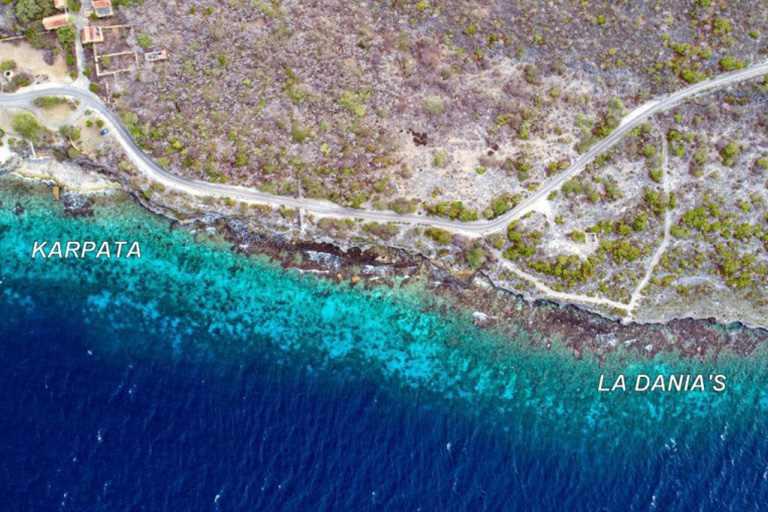Bonaire Pros
Four Great Dives For The Experienced Bonaire Shore Diver
Bonaire is world-famous for its fantastic shore diving, and with good reason. With dozens and dozens of marked shore dive sites scattered along the island’s western coastline, there is never a shortage of options for exploring the Bonaire National Marine Park. There are dives for every skill level, too.
But if you’re a seasoned Bonaire shore diving visitor, perhaps you’re searching for someplace new to explore? The sites that favor those who are comfortable and confident in more challenging shore diving conditions are some of Bonaire’s least visited and most breathtaking!
When we’re craving a little more adventure on our shore dives, here are a few of our “go to” spots.

Willemstoren Lighthouse
Situated on the southeastern tip of the island, this site favors the advanced diver primarily due to its remote location, wave conditions, and challenging shore entry. A rough, rocky coast means you’ll be picking your way down and into the water over slippery and uneven terrain. If the wind is up, the waves will be too — adding an additional level of challenge to your entry and exit. Because of the challenges, it’s best to do this dive on low wind/low wave days, so you can start and end your dive as stress-free as possible.
Once you’re in the water and under the wave break, though, the magic begins. The underwater topography features pristine elkhorn coral just a few feet from the shoreline. There’s also a lush, steeply sloping reef complete with occasional overhangs where you’ll often spot lobster and other sea creatures. Keep an eye to the dark blue, since pelagics can often be spotted going by in the oftentimes vigorous current.

White Slave
One of Bonaire’s main historic and scenic attractions, the 10 small slave huts mark this less visited site. White Slave’s location on a prominent point along the southwest coast is subject to varying current which can sometimes be strong. The entry is also a relatively steep slope of loose coral. This means every footstep really counts, especially when you’re fully geared up. There can also be the occasional large waves breaking on the shore, depending on the wind direction.
However, when conditions are favorable, this dive offers a great variety of marine life to experience. From the shallows populated with soft and hard coral (Eagle Rays are often spotted here) to the lush, sloping reef exploding with all types of sponges, you’ll find an ever-changing cast of aquatic characters hanging out throughout the day. Divers enjoy the best of Bonaire’s reefs in one beautiful dive along with an interesting look back on Bonaire’s earlier times.

La Dania’s Leap to Karpata Drift Dive
Feeling really adventurous? Head north and look for the yin/yang symbol painted on the road just past the Tolo/Ol’ Blue dive site. You’ll see a rugged footpath leading down to a rocky cliff perched 3 feet above the ocean. Officially marked as a boat dive-only site, La Dania’s Leap can be done as a giant stride entry (leap) with a drift dive to Karpata — if you are an experienced and confident diver.
Drop your gear and your divers off at the start of the footpath, then have a driver go and park your vehicle at Karpata. Once the driver walks the short distance back to La Dania’s, the group can gear up and walk down to the cliff, spot the marine park buoy just off the coastline, inflate BCDs, and leap for an exhilarating start to your dive. The dive takes about 45 minutes in normal conditions (no current to a mild north-running current) to reach Karpata, where an anchor in approximately 45 feet depth signals your exit point.
While a mild current typically runs to the north, this is never guaranteed. Also important to note is that there are no entry/exit points between La Dania’s and Karpata, so once you leap you’re in for the duration! If this sounds like fun but you’re not sure of doing it by yourself, you’ll find a number of island dive operations offering this as a guided shore dive.
Playa Franz
Go way off the beaten path and follow the dirt road behind the BOPEC facility in the north to reach Playa Frans. Not an officially marked Marine Park site, this is a great chance to explore the most northerly marine topography without entering the Washington-Slagbaai National Park. We classify this dive as advanced due to its extremely remote location, moderate to strong current and the rugged drive to get there.
You’ll find an active local fishing community here, complete with a few small structures and numerous traditional Bonairean fishing boats bobbing just off the coastline. Park anywhere out of the way, gear up, and head in the water near the concrete jetty.
The reef starts at a depth of 20 feet and the drop off is punctuated by large coral formations, creating a rugged landscape. The underwater life here is very diverse thanks to the nutrient rich currents. After your dive, be sure to check out the saliña across from the sea. It’s a very popular spot to see flamingos.
Best Shore Dive Tip
Play it safe and hire a guide. Or get one of the shore diving guide books available at most of the dive shops on the island (we suggest Dive Guide Bonaire by Marloes Otten) so that you can plan your dive with confidence. Contact us and we will be happy to assist you with any of your trip planning details.
